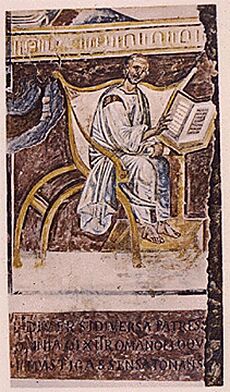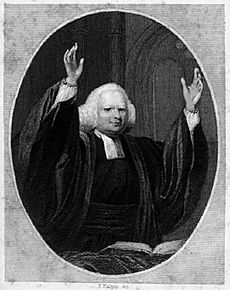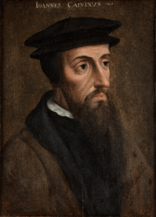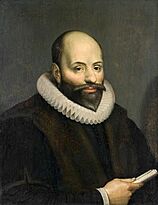History of the Calvinist–Arminian debate facts for kids
The history of the Calvinist–Arminian debate is about a big disagreement in Christianity. It started in the early 1600s in the Netherlands. This debate was between followers of John Calvin and Jacobus Arminius. It still goes on today among some Protestants.
The main topic of the debate is soteriology. This is a fancy word for the study of salvation. It includes ideas like total depravity (how much sin affects people). It also covers predestination (whether God chooses who is saved). And it discusses atonement (how Jesus' death saves people). This debate got its name in the 1600s. But similar ideas have been discussed in Christianity since the 400s. That was when Augustine of Hippo argued with the Pelagians.
Contents
Early Christian Ideas on Salvation
Augustine and Pelagius

Pelagius was a British monk who visited Rome around 400 A.D. He was upset by what he saw as bad behavior in churches. To fix this, he taught that people were saved by faith. But he also said human effort and good actions were needed. He had read Augustine's book Confessions. Pelagius thought Augustine's ideas made human nature seem too bad.
Pelagius' followers went even further. They said salvation came mainly from good actions and being moral. This idea is called Pelagianism. We know about Pelagius mostly from the writings of his opponents. These were Augustine and Jerome.
Augustine disagreed with Pelagius. He taught about original sin, which Pelagius denied. Augustine also taught a form of predestination. This means God chooses who will be saved. Some say Augustine taught that God's grace is irresistible. They also say he believed in limited atonement. This means Jesus died only for those God chose.
However, other thinkers disagree. They say Augustine's writings do not fully support these ideas. Critics also suggest Augustine's ideas might have come from Greek philosophy. He studied Platonism and Manichaeism. These philosophies often saw the human spirit as good and the body as bad.
Augustine argued that humans could do little good on their own. So, he believed, humans cannot even choose salvation. God must choose individuals to save. A group of bishops tried to defend Pelagius' views. But the First Council of Ephesus rejected their ideas in 431. Later, a group of monks in France also tried to explain predestination. They linked it to God knowing the future. But Augustine wrote more books to support his teachings. These writings helped his ideas stay important.
Semi-Pelagianism and Semi-Augustinianism
After Augustine died, a milder form of Pelagianism appeared. This idea said that a person's faith was an act of free will. It claimed this free will did not need God's grace to start. The Second Council of Orange met in 529 to discuss this. They had to decide if this "semi-Pelagianism" was right. Or if Augustine's teachings should be confirmed.
The Council's decision was a mix, sometimes called "semi-Augustinian." It said that faith is a free act. But it also said that God's grace helps it begin. God's grace enlightens the human mind. This grace helps people believe. However, the Council also rejected strict predestination. It said that God does not choose anyone to be evil. It called anyone who believed this idea "anathema" (cursed). The Pope approved this document.
Calvinist reformers later used this Council's rules. They said it showed that their ideas about original sin were old church teachings. Arminian thinkers also use the Council of Orange. They say it confirms human sinfulness and God's prevenient grace. But they also say it does not teach that grace is irresistible. And it does not fully agree with Augustine's strict predestination.
The Debate Begins: Arminius and Dort
Jacobus Arminius studied theology in Geneva in the 1580s. His teacher, Theodore Beza, praised him highly. In 1587, Arminius became a pastor in Amsterdam.
Arminius joined the predestination debate two years later. City officials asked him to argue against a changed version of Beza's ideas. Arminius studied the Bible and felt it did not support Calvinism. Other scholars think Arminius never fully agreed with Beza's views. Arminius tried to avoid controversy. He only caused a stir with two sermons on parts of the Bible (Romans 7 and 9).
When Arminius became a theology professor in 1603, the debate grew. Arguments about predestination had happened before in the Dutch Reformed Church. But now the conflict moved to the university. This was where future ministers were trained.
Arminius taught that Calvinist predestination made God the cause of evil. He argued that God's choice of who is saved was based on their faith. So, it was "conditional on faith." Arminius also said that God knowing everything ahead of time did not mean everything was already decided.
Arminius and his followers wanted a national meeting of churches. They hoped to get their views accepted. His opponents in the Dutch Reformed Church disagreed. They said local church meetings had enough power. When the government tried to bring the groups together, Arminius's opponents accused him. They said he taught wrong ideas about the Bible and other beliefs. Arminius denied these charges. He said he agreed with both Calvin and the Bible.
Arminius was found innocent of wrong teachings. He then agreed to a meeting with his opponent, Franciscus Gomarus. But Arminius's health was poor, and the meeting ended early. He died two months later, on October 19, 1609.
The Remonstrants and Calvinist Reaction
After Arminius died, his follower Johannes Wtenbogaert continued his cause. Wtenbogaert was a pastor and friend of Arminius. He strongly supported the idea that the government should have power over church matters. This was seen as a betrayal by Gomarus's side. Wtenbogaert had once opposed government influence in the church.
It became harder for Arminian-minded students to become ministers. During their exams, they had to agree to church statements. But they were also asked tricky questions. These questions made it impossible to give unclear answers.
To fight this pressure, Wtenbogaert wrote a petition. It was called a Remonstrance. This happened in late 1609 or early 1610. The "Remonstrants" (Arminius's followers) listed five main points of their beliefs:
- 1. God's choice of who is saved depends on their foreseen faith.
- 2. Jesus' death was for everyone, not just a few.
- 3. Humans are completely affected by sin (total depravity).
- 4. God's grace helps people, but they can choose to resist it.
- 5. People need to keep believing to stay saved. They also said it was possible to lose salvation.
Forty-four ministers signed the Remonstrance. It was given to the political leader, Johan van Oldenbarnevelt. Because of this document, Arminius's followers were called Remonstrants. Oldenbarnevelt held onto the document for a long time. It was finally given to the government in June 1610. The government told churches not to be too strict in their exams. But most churches ignored this.

The government tried another meeting to avoid a big church council. This was the Hague Conference in 1611. At this meeting, Arminius's opponents responded to the Remonstrance. Their response was called the Counter-Remonstrance.
Important leaders among the Remonstrants were Johannes Wtenbogaert, lawyer Hugo Grotius, and scholar Simon Episcopius. King James I of England supported the Remonstrants. This was because they believed the government was above the church.
Behind the religious debate was a political one. Prince Maurice was a strong military leader. He wanted war with Spain, a Catholic country. Johan van Oldenbarnevelt was a powerful politician. He, along with Arminius and his followers, wanted peace.
Many historians believe that politicians sided with the Remonstrants for political reasons. They agreed on the government's power over the church. It was not always about their shared religious ideas.
After Arminius died, Prince Maurice became convinced that Oldenbarnevelt had Catholic sympathies. He thought Oldenbarnevelt was trying to give Holland to Spain. Maurice and his army began replacing Remonstrant officials with Calvinist ones. So, when the government called for a church council in 1618, the outcome was already decided. Oldenbarnevelt and Grotius were arrested. The council, called the Synod of Dort, was held.
The Synod of Dort included Calvinist leaders from other countries. But Arminians were not allowed to join. Three Arminian delegates did get seats. But they were soon forced out and replaced by Calvinists.
The Synod lasted over six months. It had 154 meetings. The Synod finally decided that Arminius's teachings were wrong. It confirmed the Calvinist beliefs. One result of the Synod was the creation of the five points of Calvinism. These points directly answered the five articles of the Remonstrants.
After the Synod, Arminian pastors were punished. About 200 of them lost their jobs. Those who refused to be silent were sent out of the country. Spies looked for those who returned. Some were jailed, like Grotius, who later escaped. Five days after the Synod, Oldenbarnevelt was executed.
Later, after Prince Maurice died, the Remonstrants were allowed to practice their religion. They could build churches and schools. The Remonstrant Theological Seminary was started. Episcopius and Grotius were early professors there. Today, the seminary and church have changed some of their original beliefs.
Methodism and the Debate

These religious ideas caused arguments in the early history of Methodism in the 1700s. Methodist ministers John Wesley and George Whitefield had strong debates about Arminianism. In 1740, Wesley stopped believing in Calvinism. This led to a split with the Welsh Calvinistic Methodists. Later, it led to the creation of the Countess of Huntingdon's Connexion. In the 1770s, Wesley had a sharp debate with Augustus Montague Toplady.
Wesley strongly supported Arminius's teachings. He defended his ideas about soteriology (salvation). He wrote articles like Predestination Calmly Considered. Wesley defended Arminius against claims of semi-Pelagianism. He strongly believed in original sin and total depravity. But Wesley also attacked the idea that God chooses everyone's path. He believed people could lose their salvation. Whitefield argued with Wesley on most points. But they both agreed on total depravity.
Different Church Views Today
Protestant Churches
Today, Methodists and related groups often follow Arminian ideas. These include Pentecostals and Third Wave churches. General Baptists also usually agree with Arminianism. On the other hand, Presbyterians, Reformed Churches, and Reformed Baptists usually follow Calvinism.
Lutheranism was not as involved in this debate. This is because it started in Germany and Scandinavia. Official Lutheran teaching does not fully support either group. It has its own ideas about human freedom and God's power. This is also true for Primitive Baptist beliefs.
Restorationist churches usually believe in free will regarding salvation. For example, Churches of Christ often quote the Bible to support their view. They often disagree with Presbyterians and Calvinistic Baptists. In small towns, Churches of Christ often agree with Methodists. They both oppose the idea of "once-saved-always-saved". This is despite Churches of Christ and Baptists both practicing immersion baptism.
Eastern Orthodox Views
A meeting of Eastern Orthodox Churches happened in Jerusalem in 1672. It was called to reject Calvinist ideas. This Synod of Jerusalem (1672) strongly rejected Calvinism. It called Calvinist ideas heresy. The Synod stated:
"We believe God chose some people for glory and some for condemnation. But He did not do this without reason. He knew that some would use their free will rightly. And others would use it wrongly. So, He chose some and condemned others."
In the same document, the Synod clearly rejected Calvin. It said that anyone teaching God chose people for evil or Hell was cursed.
Images for kids
-
Thomas Aquinas (1225–1274) in a portrait, around 1400.
-
Desiderius Erasmus (1466/69–1536) in a 1523 portrait.





